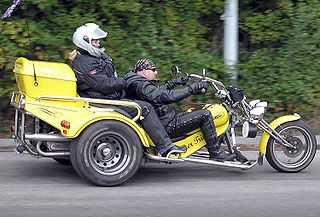This article needs additional citations for verification .(December 2012) |
Poinard is a former French auto-maker. The vehicles commenced development in 1951, were presented to the public in 1952, [1] and withdrawn from production in 1953.
This article needs additional citations for verification .(December 2012) |
Poinard is a former French auto-maker. The vehicles commenced development in 1951, were presented to the public in 1952, [1] and withdrawn from production in 1953.
The only model produced was a three-wheeler urban cycle car which closely resembled the side-car half of a motor-cycle/side car combination. This reflected Poinard's main business as a side-car manufacturer. The driver sat alone on a saddle controlling the front wheel using a motorcycle style handle-bars. Close behind the driver was a bench seat suitable for two narrow passengers, although doubts have been expressed as to whether the vehicle's engine power would have been sufficient to move so many people. [1]
The Poinard was one of several cycle cars of the period to be powered by an Ydral single cylinder 125 cc two stroke engine positioned to the rear and delivering a claimed 4 hp of power.

A sidecar is a one-wheeled device attached to the side of a motorcycle, scooter, or bicycle, making the whole a three-wheeled vehicle. A motorcycle with a sidecar is sometimes called a combination, an outfit, a rig or a hack.

Panhard was a French motor vehicle manufacturer that began as one of the first makers of automobiles. It was a manufacturer of light tactical and military vehicles. Its final incarnation, now owned by Renault Trucks Defense, was formed by the acquisition of Panhard by Auverland in 2005, and then by Renault in 2012. In 2018 Renault Trucks Defense, ACMAT and Panhard combined under a single brand, Arquus.

The Isetta is an Italian-designed microcar built under license in a number of different countries, including Argentina, Spain, Belgium, France, Brazil, Germany, and the United Kingdom. Because of its egg shape and bubble-like windows, it became known as a bubble car, a name also given to other similar vehicles.

Propulsion transmission is the mode of transmitting and controlling propulsion power of a machine. The term transmission properly refers to the whole drivetrain, including clutch, gearbox, prop shaft, differential, and final drive shafts. In the United States the term is sometimes used in casual speech to refer more specifically to the gearbox alone, and detailed usage differs. The transmission reduces the higher engine speed to the slower wheel speed, increasing torque in the process. Transmissions are also used on pedal bicycles, fixed machines, and where different rotational speeds and torques are adapted.

A steering wheel is a type of steering control in vehicles.
The Alta Car and Engineering Company was a British sports and racing car manufacturer, commonly known simply as Alta. Their cars contested five FIA World Championship races between 1950 and 1952, as well as Grand Prix events prior to this. They also supplied engines to a small number of other constructors, most notably the Connaught and HWM teams.
In automotive engineering, a mid-engine layout describes the placement of an automobile engine in front of the rear-wheel axles, but behind the front axle.

The Peugeot 203 is a small family car which was produced by the French car manufacturer Peugeot between 1948 and 1960.

The Daimler Scout Car, known in service as the Daimler Dingo, is a British light, fast four-wheel drive reconnaissance vehicle also used for liaison during the Second World War.

A motorized bicycle is a bicycle with an attached motor or engine and transmission used either to power the vehicle unassisted, or to assist with pedalling. Since it sometimes retains both pedals and a discrete connected drive for rider-powered propulsion, the motorized bicycle is in technical terms a true bicycle, albeit a power-assisted one. Typically they are incapable of speeds above 52 km/h (32 mph).
FIM Sidecar World Championship is the international sidecar racing championship. It is the only remaining original FIM road racing championship class that started in 1949.

Bond Minicar is a series of economical three-wheeled microcars which were manufactured by the British car manufacturer Sharp's Commercials Ltd, in Preston, Lancashire, between 1949 and 1966.

Fuldamobil is the name of a series of small cars produced by Elektromaschinenbau Fulda GmbH of Fulda, Germany, and Nordwestdeutscher Fahrzeugbau (NWF) of Wilhelmshaven between 1950 and 1969. Various designated versions of the car were produced, although the vehicles produced under each designation were not always identical and the designations were sometimes misapplied. Though overall numbers produced were relatively small, the cars attracted sufficient attention to see licensed construction on four continents including Europe. In its ultimate configuration it is said to have inspired the term "bubble car". It is acknowledged as the first car in the world to feature a negative scrub radius, now recognised as a major advance in driving safety.

Tempo, was a German automobile manufacturer based in Hamburg. The company was founded by Oscar Vidal in 1924.

The Renault Colorale is a mid-size car manufactured and marketed by Renault for model years 1950-1957. Featuring the profile of a small station wagon/estate, the Colorale's styling anticipated successful Renault designs of the 1960s. The Colorale was not a commercial success.
Lambert was a French automobile manufacturer established by Germain Lambert in 1926 at Mâcon. In commercial terms it never progressed beyond marginal viability and it withdrew from auto-making towards the end of 1953.

Georges Mochet began to produce cycle-cars at his, now-demolished, premises at 68, Rue Roque-de-Fillol at Puteaux in approximately 1946 and by about 1952 had progressed to more modern looking two seater micro-cars and powered two-wheelers. In 1958, with approximately 3,000 vehicles manufactured, production ended.
Reyonnah is a former French automaker. It produced 16 cycle-car style vehicles between 1951 and 1954.

A motorized tricycle, motor trike, or motortrycle is a three-wheeled vehicle based on the same technology as a bicycle or motorcycle, and powered by an electric motor, motorcycle, scooter or car engine.